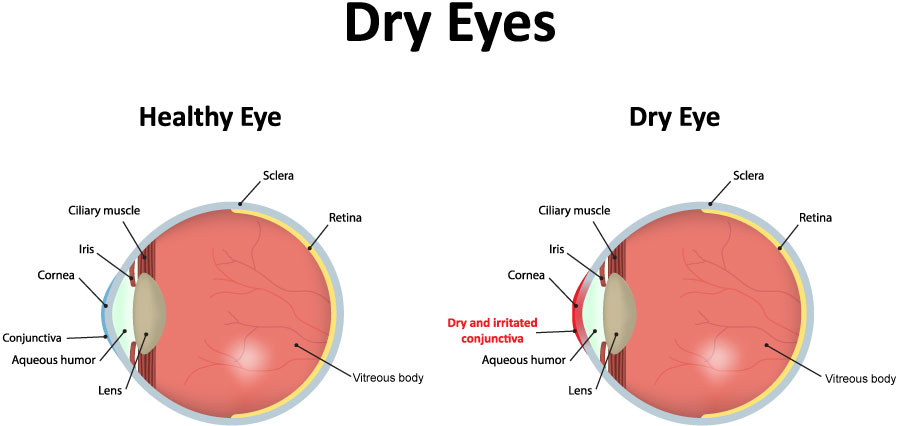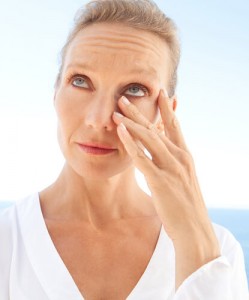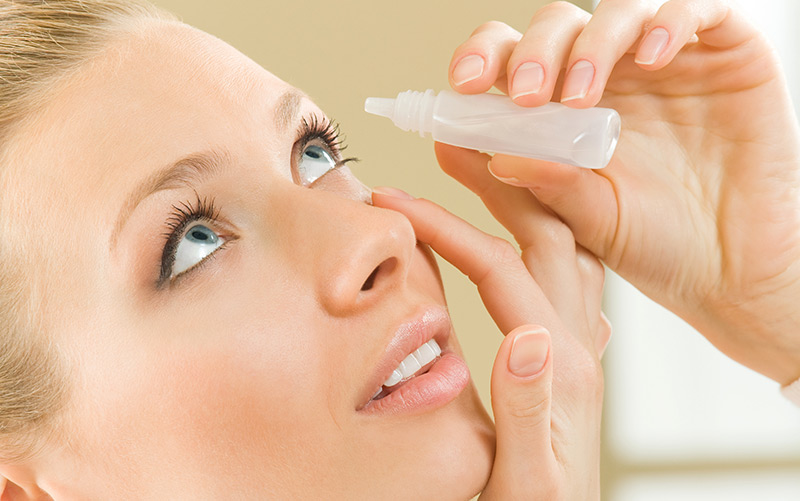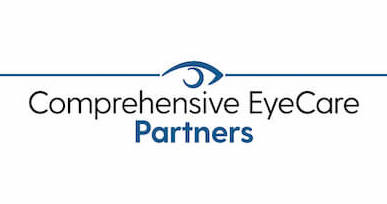What is Dry Eye?
Some people do not produce enough tears to keep the eye comfortable. This is known as dry eye. Tears are produced by two different methods. One method produces tears at a slow, steady rate and is responsible for normal eye lubrication. The other method produces large quantities of tears in response to eye irritation or emotions. Tears that lubricate are constantly produced by a healthy eye. Excessive tears occur when the eye is irritated by a foreign body or when a person cries.
What are the Symptoms of Dry Eye?

The usual symptoms include:
- Stinging or burning eyes
- Scratchiness
- Stringy mucus in or around the eyes
- Eye irritation from smoke or wind
- Excess tearing
- Difficulty wearing contact lenses
Excess tearing from “dry eye” sounds illogical, but if the tears responsible for maintenance lubrication do not keep the eye wet enough, the eye becomes irritated. When the eye is irritated, the lacrimal gland produces a large volume of tears which overwhelms the tear drainage system. These excess tears then overflow from your eye.
What is the Tear Film?
A film of tears, spread over the eye by a blink, makes the surface of the eye smooth and clear. Without our tear film, good vision would not be possible. The tear film consists of three layers:
- An oily layer
- A watery layer
- A layer of mucus
The oily layer, produced by the meibomian glands, forms the outermost surface of the tear film. Its main purpose is to smooth the tear surface and reduce the evaporation of tears. The middle watery layer makes up most of what we ordinarily think of as tears. This layer, produced by the lacrimal gland, cleanses the eye and washes away foreign particles or irritants. The inner layer consists of mucus produced by the conjunctiva. Mucus allows the watery layer to spread evenly over the surface of the eye and helps the eye remain wet. Without mucus, tears would not adhere to the eye.

What Causes Dry Eye?
Tear production normally decreases as we age. Although dry eye can occur in both men and women at any age, women are most often affected. This is especially true after menopause. Dry eyes can also be associated with arthritis and accompanied by a dry mouth. People with dry eyes, dry mouth and arthritis are said to have Sjogren’s syndrome. A wide variety of common medications — prescription and over-the-counter — can cause dry eye by reducing tear secretion. Be sure to tell your ophthalmologist the names of all the medications you are taking, especially if you are using:
- Diuretics
- Betablockers
- Antihistamines
- Sleeping pills
- Medications for “nerves”
- Pain relievers
Since these medications are often necessary, the dry eye condition may have to be tolerated or treated with “artificial tears.” People with dry eyes are often more prone to the toxic side effects of eye medications, including artificial tears. For example, the preservatives in certain eye drops and artificial tear preparations can irritate the eye.
How is Dry Eye Diagnosed?
An ophthalmologist (medical eye doctor) is usually able to diagnose dry eye by examining the eyes. Sometimes tests that measure tear production may be necessary. One test, called the Schirmer tear test, involves placing filter-paper strips under the lower eyelids to measure the rate of tear production under various conditions. Another uses a diagnostic drop to look for certain staining patterns.
How is Dry Eye Treated?

BlephEx
Shepherd Eye Center proudly offers BlephEx, a treatment for those suffering from red, dry, crusted, swollen, irritated eyes or flaky eyelids. If you have any of these symptoms you may have a common condition known as blepharitis.
What is Blepharitis?
Blepharitis is caused by a buildup of bacteria on or under the eyelids. Having bacteria on your skin is normal, but too much bacteria can cause problems. You can also get blepharitis if the oil glands in your eyelids get clogged or irritated.
Why Do You Need BlephEx?
Not only is blepharitis uncomfortable, but if left untreated it can cause significant damage to the eyelids and tear glands potentially leading to chalazions (a small, slow-growing lump or cyst that develops within the eyelid) and dry eye disease.
In some cases, patients develop posterior blepharitis (inside the eyelid), which is a result of meibomian gland dysfunction (MGD). MGD is also a leading cause of dry eye syndrome, and the conditions share many symptoms.
What is BlephEx and what can you expect during treatment?
BlephEx is a doctor-administered in-office eyelid cleaning procedure. They begin by numbing your eyes to prevent any discomfort during the treatment. Then they use a handheld BlephEx device to run the medical-grade micro-sponge along your eyelids and eyelashes. A fresh micro-sponge tip is used for each eye and in just 6-8 minutes our doctors are able to safely remove the biofilm and bacteria from your eyelids. Patients report a tickling sensation during the cleaning but no severe discomfort.
Following BlephEx treatment, you should notice an immediate decrease in your blepharitis symptoms and an overall improvement in eyelid health. You can resume your normal daily activities immediately as there is no downtime associated with BlephEx and treatments may be performed every four to six months.
Schedule an appointment at Shepherd Eye Center in Las Vegas, NV. Your eye doctor will talk to you about keeping your eyelids bacteria and debris-free.
Other Treatment Options:
Adding tears: Eye drops called artificial tears are similar to your own tears. They lubricate the eyes and help maintain moisture. Artificial tears are available without a prescription. There are many brands on the market, so you may want to try several to find the one you like best. Preservative-free eye drops are available if you are sensitive to the preservatives in artificial tears. If you need to use artificial tears more than every two hours, preservative-free brands may be better for you. Solid artificial tear inserts that are placed inside the lower lid on a daily basis and gradually release lubricants may be beneficial to some people. You can use the tears as often as necessary—once or twice a day or as often as several times an hour.
Conserving the tears: Conserving your eyes’ own tears is another approach to keeping the eyes moist. Tears drain out of the eye through a small canal into the nose (that is why your nose runs when you cry). Your ophthalmologist may close these canals either temporarily or permanently. The closure conserves your own tears and makes artificial tears last longer.
Other methods: Tears evaporate like any other liquid. You can take steps to prevent evaporation. In winter, when indoor heat is on, a humidifier or a pan of water on the radiator adds moisture to dry air. Wrap-around glasses may reduce the drying effect of the wind, but are illegal to wear while driving in some states. Anything that may cause dryness, such as an overly warm room, hair dryers or wind, should be avoided by a person with dry eye. Smoking is especially bothersome. Some people with dry eye complain of “scratchy eyes” when they wake up. This symptom can be treated by using an ointment at bedtime. Use the smallest amount of ointment necessary for comfort, since the ointment can cause your vision to blur temporarily. Dry eye due to a lack of vitamin A in the diet is rare in the United States but is more common in poorer countries, especially among children. Ointments containing vitamin A can help dry eye if it is caused by unusual conditions such as Stevens-Johnson syndrome or pemphigoid. Vitamin A supplements do not seem to help people with ordinary dry eyes.


